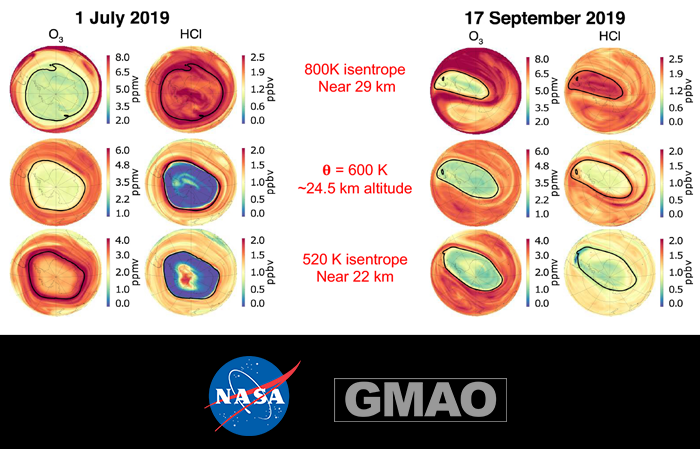The anomalous 2019 polar stratospheric chemistry in GMAO’s assimilation experiments
Extreme stratospheric ozone depletion has been a fixture of austral spring seasons (September-November) since the early 1980s. Chemical depletion of polar ozone is catalyzed by active halogen molecules chemically activated within the lower portion of the stratospheric polar vortex. Particularly significant ozone loss over Antarctica leads to the formation of ozone holes. The main source of stratospheric halogens (primarily chlorine) was industrial emissions of chlorofluorocarbons in the second half of the 20th century. As these emissions have been successfully phased out following the Montreal Protocol and related international agreements, the severity of ozone depletion over Antarctica has stabilized. Ozone holes are expected to close shortly after mid-century, once the remaining anthropogenic chlorine has been removed from the stratosphere by large scale circulation processes (WMO 2018). Year-to-year variability of the polar vortex dynamics, driven by planetary-scale wave activity in the southern midlatitudes, modulates the severity of ozone depletion, as well as the size and exact timing of the ozone hole.
At the end of August 2019, a rare sudden stratospheric warming (SSW) commenced in the Southern Hemisphere as a result of anomalously high wave activity (Hendon et al., 2019; Shen et al., 2020; Rao and Garfinkel 2020), which led to a significant tilting and shrinking of the polar vortex and a rapid rise of the vortex temperature through adiabatic compression resulting from accelerated sinking of air within the polar vortex. As a result, the 2019 ozone hole was the smallest since the late 1980s and closed in early November, about one month earlier than usual (Wargan et al., 2020; Safieddine et al., 2020).
The Anomalous 2019 Polar Stratospheric Chemistry in GMAO’s Assimilation Experiments
Smaller, distorted and displaced polar vortex following the sudden stratospheric warming. Low ozone. Increased HCl signals chlorine deactivation. Evidence of wave breaking.

Using the new Constituent Data Assimilation System (CoDAS) developed at the GMAO, we conducted an analysis of the dynamical and chemical evolution of the 2019 polar vortex and ozone depletion. This configuration of the CoDAS is constrained by observed stratospheric profiles of ozone, HCl, HNO3, water vapor and N2O from the Microwave Limb Sounder (MLS) along with total column ozone observations from the Ozone Monitoring Instrument (OMI). Both MLS and OMI fly on NASA’s EOS Aura satellite and provide invaluable data on atmospheric composition since late 2004. The data assimilation experiments were run in the so-called replay mode, whereby the GEOS general circulation model (GCM) is forced by assimilated meteorological fields from GMAO’s MERRA-2 reanalysis. The CoDAS uses a stratospheric chemistry model named StratChem. The GEOS GCM and StratChem propagate observational data in space and time allowing the system to generate data driven high-resolution, three-dimensional maps of stratospheric composition.
This animation shows the evolution of ozone, the chlorine reservoir compound HCl, water vapor and N2O at four selected potential temperature levels over the southern high latitudes between 1 July and 31 October 2019. It is readily seen that chemical composition of the polar vortex (marked by a black contour in each panel) differed dramatically from that at midlatitudes. This was a result of chemical processing whereby chlorine reservoir species, HCl and ClONO2 (not shown), were converted to active chlorine that subsequently destroyed ozone. Chlorine activation occurred on the surfaces of polar stratospheric clouds (PSCs) that formed in the very low temperatures inside the polar vortex. Very low concentrations of HCl between July and mid-September indicate chlorine activation. The formation of PSCs involves condensation of water vapor and, therefore, dehydration seen at the 520° K level (approximately 22 km).
Extremely low N2O arises from downward transport within the polar vortex. Chemical depletion of ozone that began in July and lasted until mid-September was responsible for the low ozone values at 520° and 600° K (up to about 25 km). These processes are typical for Antarctic winters in recent decades. However, the 2019 SSW dramatically distorted, displaced and reduced the polar vortex pushing the relatively ozone-rich mid-latitudinal air masses in the middle stratosphere (above 600° K) over the high latitudes, leading to a rapid rise of the total column ozone. The distortion of the polar vortex is seen in the animation at all four levels starting in early September. Because of a sharp rise of the vortex temperature, the SSW also led to an early chlorine deactivations and cessation of chemical ozone depletion. Rising concentrations of the vortex HCl around mid-September indicate the return of polar chlorine to its chemically inert form.
In addition to furthering our understanding of this anomalous austral winter/spring season, this analysis highlights the value of chemical data assimilation that allows researchers to follow complex dynamical and chemical processes occurring in the polar stratosphere at high spatial and temporal resolution with great fidelity that arises from strong observational constraints.
This snapshot is based on the results presented in Wargan et al. (2020).
References:
Hendon, H. H., D.W. Thompson, E.-P. Lim, A.H. Butler, P.A. Newman, L. Coy et al. (2019), Rare forecasted climate event under way in the Southern Hemisphere. Nature, 573(7775), 495–495. https://doi.org/10.1038/d41586-019-02858-0
Rao, J., Garfinkel, C. I., White, I. P., and Schwartz, C. (2020). The Southern Hemisphere minor sudden stratospheric warming in September 2019 and its predictions in S2S models. Journal of Geophysical Research: Atmospheres, 125, e2020JD032723. https://doi.org/10.1029/2020JD032723
Shen, X., Wang, L., and Osprey, S. (2020). Tropospheric forcing of the 2019 Antarctic sudden stratospheric warming. Geophysical Research Letters, 47, e2020GL089343. https://doi.org/10.1029/2020GL089343
Wargan, K., Weir, B., Manney, G. L., Cohn, S. E., & Livesey, N. J. (2020). The anomalous 2019 Antarctic ozone hole in the GEOS Constituent Data Assimilation System with MLS observations. Journal of Geophysical Research: Atmospheres, 125, e2020JD033335. https://doi.org/10.1029/2020JD033335
WMO (World Meteorological Organization) (2018). Scientific assessment of ozone depletion: 2018. Global Ozone Research and Monitoring Project–Report No. 58, 588 pp., Geneva, Switzerland


